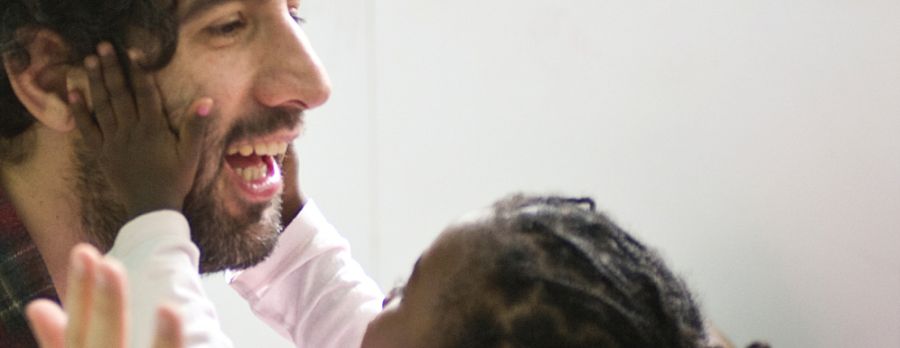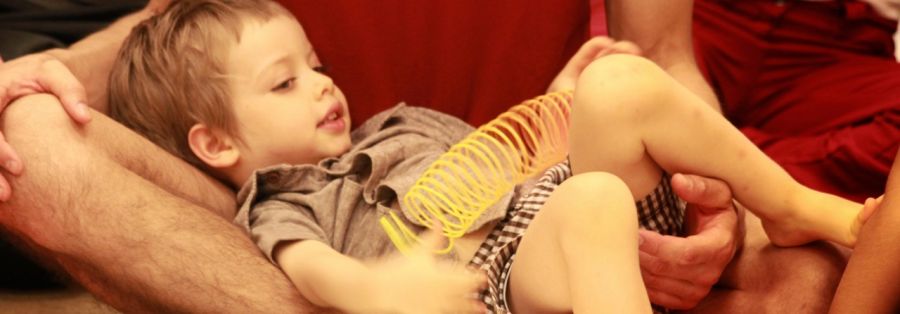




Ainda
bem que a Primavera traz entusiasmo pois além do trabalho
regular com Creche e Apareche, Maio será um mês de várias
frentes. Logo no início, o Colo da Terra estreará nos Dias da
Música no CCB. Trata-se da mais recente proposta da CMT num dos
campos onde tem sido pioneira, a música para bebés. Em Colo da
Terra, a música tradicional portuguesa é o tema que organiza, de
forma informal, lúdica e imaginativa, uma proposta de construção
de pontes de comunicação entre pais e filhos, baseadas nos
afectos e na descoberta da musicalidade das emoções.
É tempo de Primavera e brotam PaPIs (Peça a Peça Itinerante) trazendo cor à vida de muitas crianças, Pais e educadores. Opus 2 e Opus 7 estarão em várias creches, jardins de infância e também em dois hospitais. O São Luiz Teatro Municipal está connosco em Pontes de PaPI e apresentará Opus 6, levando também esta peça a uma creche e jardim de infância da sua área geográfica. São assim as Pontes de PaPI: estabelecem diálogos institucionais. Entre Cultura e Educação há sempre uma Ponte de PaPI.
E, “Im wunderschönen Monat Mai”, o céu e as montanhas da Áustria vão vibrar com a graça e a poesia de Anatomia do Piano que será apresentada no Next Liberty em Graz.
É tempo de Primavera e brotam PaPIs (Peça a Peça Itinerante) trazendo cor à vida de muitas crianças, Pais e educadores. Opus 2 e Opus 7 estarão em várias creches, jardins de infância e também em dois hospitais. O São Luiz Teatro Municipal está connosco em Pontes de PaPI e apresentará Opus 6, levando também esta peça a uma creche e jardim de infância da sua área geográfica. São assim as Pontes de PaPI: estabelecem diálogos institucionais. Entre Cultura e Educação há sempre uma Ponte de PaPI.
E, “Im wunderschönen Monat Mai”, o céu e as montanhas da Áustria vão vibrar com a graça e a poesia de Anatomia do Piano que será apresentada no Next Liberty em Graz.
It is Spring time, and the PaPIs (Itinerant Play to Play) are springing into action, bringing colour to many children, parents and teachers. Opus 2 and Opus 7 are running in various crèches and kindergartens as well as two hospitals. São Luiz Municipal Theatre is working with us on Pontes de PaPI (PaPI Bridges) and will put on Opus 6, also taking this piece to a crèche and kindergarten in the locality. Pontes de PaPI are like that: they forge institutional relationships. Between Culture and Education there is always a Ponte de PaPI. And, “Im wunderschönen Monat Mai”, the skies and the mountains of Austria will reverberate with the grace and poetry of Anatomia do Piano, which will be presented at the Next Liberty in Graz.


E em Famalicão tivemos uma agradável surpresa: alunos do Curso Profissional do Externato Delfim Ferreira vieram ver Opus 1 e partilharam momentos muito especiais com os seus "colegas" pequeninos. São assim as pontes de PaPI: estabelecem diálogos intergeracionais. Entre Cultura e Educação há sempre uma Ponte de PaPI.
Opus 6 esteve também no Roseiral em Lisboa. E os irmãos mais velhos dos meninos do Roseiral tiveram umas férias da Páscoa especiais no Laboratório de Música e Comunicação na Infância-CESEM: cantaram e dançaram, foram cuidados para poderem cuidar. Sim, continuamos a aperfeiçoar o modelo de trabalho em que colocamos crianças mais velhas a brincar com os mais pequeninos levadas pelas águas da Música!
Março foi também tempo de Afinação do Brincar no São Luiz Teatro Municipal e o Projecto Opus Tutti foi tema duma palestra apresentada na conferência da EPIS na Fundação Gulbenkian. Depois, rumámos para Norte e em Abril participámos na conferência da RESEO em Helsínquia onde partilhámos algumas das nossas descobertas sobre corpo e voz num workshop dirigido a adultos e intitulado "Opening the gates on musicality".
Opus 6 was also in the Roseiral in Lisbon. And the older siblings of the Roseiral children had some special Easter holidays in the Laboratory of Music and Communication – CESEM: they sang and danced, they were given care so as to be able to care themselves. Yes, we are continuing to perfect the model where we put older children to play with the younger ones, swept along with the water of Music.
March was also the time for Afinação do Brincar (Tune your Play) in São Luiz Municial Theatre and the Opus Tutti Project was the subject of a presentation given at the EPIS conference at the Fundação Calouste Gulbenkian. Then we headed north, and in April we took part in the RESEO conference in Helsinki, sharing some of our discoveries about the body and the voice in a workshop aimed at adults called “Opening the gates on musicality”.


Quando ensinei na Esproarte em Mirandela comecei a
escrever pequenas peças para orquestra de cordas e grupo de
sopros utilizando melodias tradicionais. Depois, escrevi o ciclo
Aquarium, obra para coro sobre música tradicional da Madeira.
Fui-me aproximando assim da música portuguesa de transmissão
oral. Abordar o ensino de qualquer instrumento com materiais
provenientes da cultura mais primária do aluno pode ajudar a
resolver problemas de compreensão do discurso musical muito mais
facilmente que com modelos abstractos, distantes da vida. Hoje
no meu catálogo de obras incluem-se vários trabalhos que usam a
música folclórica portuguesa. Acredito que trabalhar a partir
das raízes culturais de um povo é uma colaboração para as manter
vivas. Partilho esses trabalhos com os interessados em
www.robertoalejandroperez.com
When I was teaching at Esproarte in Mirandela, I
started to write short pieces for string orchestras and woodwind
groups using traditional melodies. Then I wrote the Aquarium
suite, a choral work based on traditional music from Madeira. As
such, I was working towards voice based Portuguese music. Taking
an approach to teaching an instrument which draws on materials
which are part of the most basic culture of the student is more
effective at resolving problems understanding the musical
discourse than the use of abstract models which are removed from
reality. Today, my catalogue of works includes a number of works
which use Portuguese folk music. I believe that work that uses
peoples’ cultural roots helps to keep them alive. Those
interested can find these works at www.robertoalejandroperez.com




Colo
da Terra, making its debut at the CCB, is the first of a set of
ideas titled Colo da Música (literally, in the lap of music).
These creations are not just practical experiments, but are also
an integral part of a publication we are writing as part of the
Opus Tutti project. Colo da Música is a set of structured
sessions drawing on principles that have been tested in a number
of projects from CMT and the Laboratory of Music and
Communication in Infancy/ CESEM at the Faculty of Social
Sciences and Humanities (UNL). Inspired by the ideas of E.
Gordon and C. Trevarthen and the experience provided by BebéBabá
and BebéPlimPlim, TAM-TAM, Orientações Musicais Para Bebés
(Musical Guidance for Babies), Musical Patchwork and Música de
Colo, the various strands of Colo da Música are united by a
model based on musical interaction with parents and babies
incorporating base elements of communications. Voice, body and
movement provide expressive channels for creating dynamic
musical environments – rich and varied, they establish
communication links between parents and children based on caring
and the discovery of the musicality of emotions. The different
strands are connected by the common material that CMT has
created or covered over the years, and it is from that cloud
that Colo da Terra, Colo dos Bichos, Colo de Plim, Colo de
Andaki, Colo de Bach, Colo de PaPI and Colo do Mundo, all
emerge.
